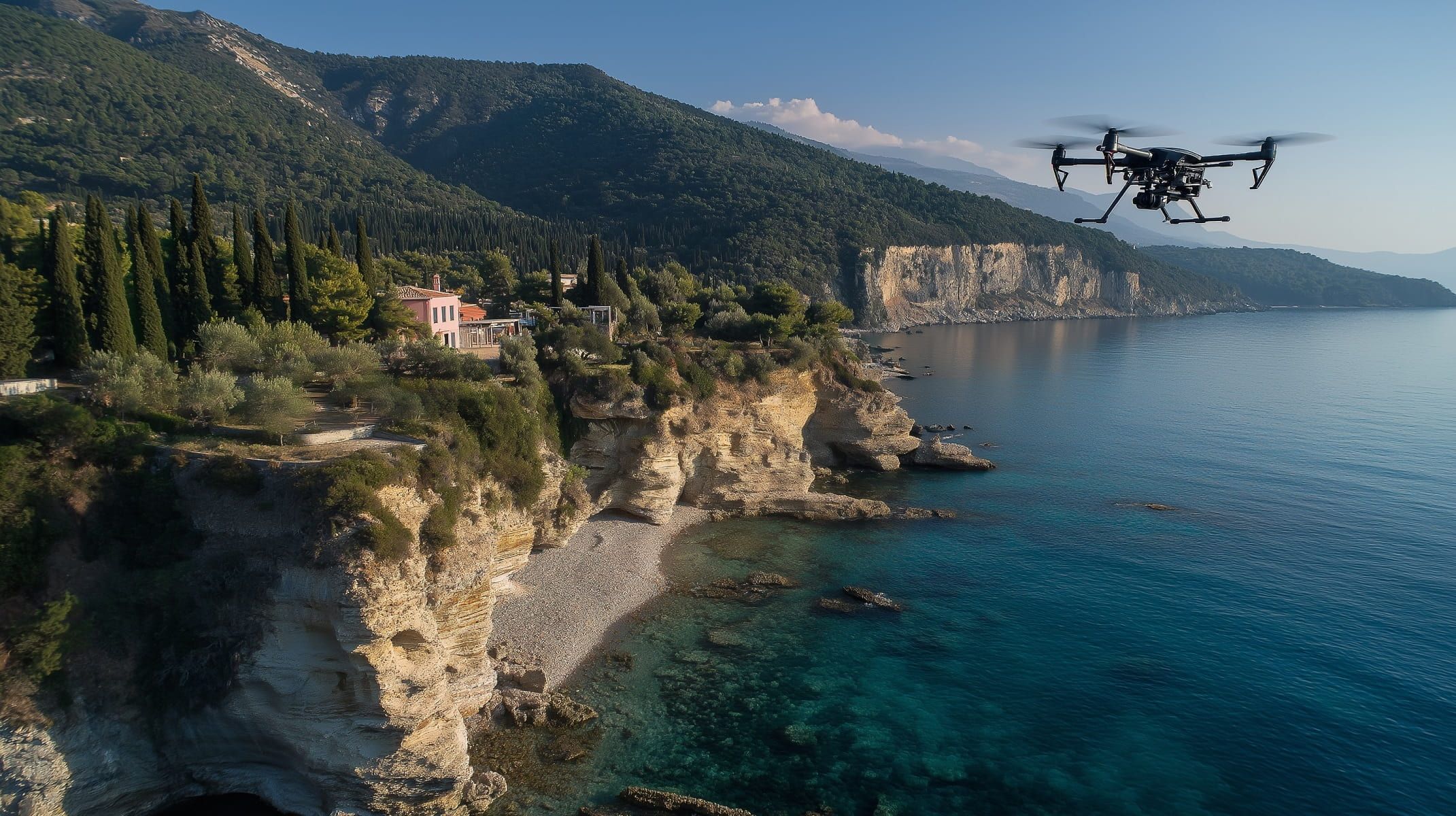- Greece implements the EU Drone Regulation 2019/947 and 2019/945, effective end of 2020, using Open, Specific, and Certified risk-based categories.
- The Open category allows drones under 25 kg to fly up to 120 meters and in visual line-of-sight with no prior authorization if the rules are followed.
- Registration is required for drones over 250 g or with a camera, via the HCAA online system, with a single UAS Operator Registration Number that covers all drones and, for non-EU residents, registration must occur before flying; once registered in one EU country, it is valid across the EU.
- Pilots must hold the EU Remote Pilot Certificate for Open Category (A1/A3); with closer-to-people or heavier Open drones (A2) an additional practical training and A2 theory exam are required, with minimum age 16.
- From 2024, Open-category drones heavier than 250 g or in classes C1–C3 must broadcast Remote ID, and new EU drones display class marks from C0 to C4.
- Operational rules require staying in VLOS, not exceeding 120 m, maintaining at least 30 m from bystanders (5 m if low-speed mode), and BVLOS is allowed only with Specific-category authorization.
- No-fly zones include an 8 km radius around airports, all military bases, archaeological sites, hospitals, prisons, and other sensitive infrastructure; check the DAGR map and obtain HCAA authorization for restricted zones, usually 3 working days in advance (5 days for military zones).
- Night flights are heavily restricted; EU rules permit night operations with appropriate lighting, but Greece generally expects daylight flights unless explicit authorization is granted.
- Commercial drone operations require third-party liability insurance (typically at least €1,000,000); insurance for recreational use is recommended and should be carried when flying.
- Penalties can reach up to €250,000, with possible criminal charges and drone confiscation; enforcement is by the HCAA with police, including high-profile site incidents near places like the Acropolis.
Regulatory Framework in Greece (EU and National Regulations)
Greece’s drone regulations are governed by both European Union rules and national requirements set by the Hellenic Civil Aviation Authority (HCAA). As an EU member, Greece follows the EU Drone Regulation (Regulations 2019/947 and 2019/945), which took effect at the end of 2020 and introduced a risk-based approach for all drone operations [1]. Notably, EU rules do not distinguish between recreational (hobbyist) and commercial drone use – instead, they classify operations by risk into three categories: Open, Specific, and Certified [2].
- EU-Wide Categories: The Open Category covers low-risk flights and most hobby or simple commercial uses. It requires no prior authorization if you follow the rules (drones <25 kg, stay within visual line-of-sight, max 120 m altitude, etc.) [3]. The Specific Category covers higher-risk operations (beyond Open limits or in sensitive areas) and requires an authorization from the national authority after a risk assessment [4]. The Certified Category is for the highest-risk uses (for example, very large drones or those carrying people) and requires certified drones, licensed pilots, and aviation-type licensing [5]. In practice, most everyday drone flights (whether for fun or work) fall under the Open category rules unless you plan something unusual or high-risk.
- National Authority (HCAA): The HCAA is the agency responsible for implementing and enforcing these rules in Greece [6]. While EU regulations provide the framework, Greece has country-specific restrictions and procedures that drone users must follow (e.g. airspace zones, permits for certain areas, etc.) [7] [8]. Always check both the EU-wide rules and the HCAA’s guidelines before flying in Greece.
Drone Registration and Pilot Licensing Requirements
Registration: Both recreational and commercial drone operators in Greece must register if their drone weighs over 250 grams or is equipped with a camera/sensor capable of capturing personal data [9]. This requirement is in line with EU rules and effectively means virtually all non-toy drones (even small camera drones) require operator registration. Registration is done via the HCAA’s online system, which issues a unique UAS Operator Registration Number that must be attached to your drone(s) [10]. The same operator ID covers all your drones. If you’re a non-EU resident bringing a drone to Greece (and have not registered in another EU country already), you must register with HCAA before flying [11] [12]. Once registered in one EU country, your operator registration is valid across all EU member states [13].
Pilot Licensing/Competency: Greece requires drone pilots to obtain the appropriate EASA competency certificates for the category of operation. For most hobbyist and routine commercial flights in the Open category, pilots need to pass an online training and exam to obtain the EU Remote Pilot Certificate for Open Category (A1/A3) [14] [15]. This is a basic theory test (available online) covering safety and airspace rules. For operations that require flying a bit closer to people or using heavier drones (subcategory A2 of Open category), an additional practical training and A2 theory exam is required [16] [17]. The minimum age for remote pilots in the Open category is generally 16 in EU, unless a lower age is set by a country (Greece adheres to the default 16 years in most cases).
Commercial operators and remote pilots essentially follow the same certification process – there isn’t a separate “commercial license,” but using a drone for any professional/commercial purpose does require that the pilot be certified and the operator registered, just as with a recreational user [18] [19]. For very high-risk operations (Specific or Certified categories), pilots may need advanced training or even a Remote Pilot License and the operator must obtain special authorization or certification from HCAA [20]. In summary, no one may lawfully fly a drone in Greece (above 250g or with a camera) without registering, and no one should pilot a drone without at least the basic EU drone certificate, regardless of hobby or commercial use [21].
Marking and Remote ID: After registration, you must label your drone with your operator registration number. Moreover, under EU standards effective 2024, drones in certain classes must have Remote ID broadcasting. New drones sold in Europe come with class identification labels (C0 through C4); any drone in the Open category that is heavier than 250g (or is in classes C1–C3) must broadcast a remote identification signal [22] [23]. If you have an older drone without a class mark, you may need to attach an add-on Remote ID module to comply with EU requirements in 2024 and beyond. Always ensure your drone’s technical features (like Remote ID and class marking) meet the current EU standards for it to be flown in Greece.
Operational Restrictions and Flight Rules
Once registered and certified, operators must adhere to strict operational rules to fly safely and legally:
- Altitude Limit: Drones may not be flown above 120 meters (400 feet) from ground level [24] [25]. This is an absolute ceiling for the Open category across Europe to minimize interference with manned aircraft. In Greece, 120m is the general max altitude; going higher would require a special authorization under Specific category, which is typically not given in normal circumstances.
- Visual Line of Sight (VLOS): You must keep your drone within visual line-of-sight at all times during flight [26] [27]. In practical terms, the pilot (or an observer helping the pilot) should always be able to see the drone with unaided vision. Greece’s older rules specified a maximum horizontal distance of about 500 meters for VLOS flights [28] [29], which is a good guideline for staying within sight. Flying beyond line-of-sight (BVLOS) is not allowed for general drone users unless you have special permission in the Specific category with a detailed safety case.
- Maximum Drone Weight: Drones over 25 kg are not allowed for civilian use in the Open category [30] [31]. 25kg is the upper limit for any Open category operation. Heavier UAS would fall into the Certified category, which involves very strict requirements (generally outside the scope of hobby or standard commercial usage).
- Distance from People (“No Overflight of Uninvolved People”): It is prohibited to fly over uninvolved persons or open-air assemblies of people for safety and privacy. Under EU rules, even in the subcategory that allows flying close to people (A2), you must maintain a safe horizontal distance (at least 30 meters, or 5 meters if the drone has a low-speed mode engaged) from bystanders [32]. Flying directly over people is only allowed for the smallest drones (<250g class C0/A1) and even then you must not fly over crowds or assemblies of people [33]. In Greece, older national rules mandated a minimum 50-meter distance from people not involved in the flight [34], and this remains a good practice even as EU rules take precedence. Always plan your flight path to avoid passersby – do not hover over public gatherings, busy roads, or anywhere people are congregated.
- Night Flights: Are drones allowed at night in Greece? – Generally, no without proper precautions. European regulations permit drone flights at night in the Open category only if the drone has appropriate lighting (a flashing green light) so it can be seen [35]. However, Greece historically had a stricter stance banning night flights outright for hobbyists. The current practical rule is that night operations are heavily restricted. If you have a compliant drone with lights, you may fly at night in the Open category, but be aware that this is advanced usage. It’s recommended to only fly in daylight unless you’ve obtained explicit authorization for a night operation [36]. (Under older HCAA regulations, night flying was prohibited from 30 minutes before sunset until 30 minutes after sunrise without a special permit [37], and while EU law has relaxed this, authorities may still scrutinize nighttime flights.) To be safe, avoid night flying unless absolutely necessary and ensure you meet all equipment requirements if you do.
- Visual Observer and FPV: Flying with FPV goggles or a camera monitor (First Person View) is allowed only if a co-located visual observer maintains eye contact with the drone. You cannot argue that the live video feed counts as VLOS – Greek authorities will consider that as beyond visual line of sight if no human watcher is keeping the drone in direct sight [38]. In short, if you use FPV, bring a friend to act as a spotter.
- Dropping Objects & Dangerous Goods: It is strictly forbidden to attach or drop dangerous materials from a drone, or to drop any objects that could cause harm [39] [40]. You also may not carry any explosive, flammable, or otherwise hazardous payload. This includes seemingly harmless “drone dropping” of items – avoid it entirely for safety and legal reasons.
- Right-of-Way: Drones must always yield to manned aircraft. If you notice a helicopter or airplane, you must immediately give way and ensure your drone stays well clear. This is a fundamental safety rule (manned aviation always has priority in shared airspace).
By following these operational rules, drone pilots can ensure they remain within the Open category privileges and do not need special permission for each flight. If you cannot meet one or more of these conditions (for example, you need to fly higher than 120m or beyond line-of-sight, etc.), then your operation would shift into the Specific category and you must apply for an authorization from HCAA in advance [41].
No-Fly Zones and Restricted Areas
Greece has strict no-fly zones and geographical restrictions to protect sensitive areas and airspace. Before every drone flight in Greece, it is mandatory to check for airspace restrictions on the official DAGR platform (Drone Aware Greece) [42]. The DAGR online map shows color-coded zones where drone flights are limited or forbidden. Key restricted areas include:
- Airports and Heliports: It is prohibited to fly within 8 kilometers (approximately 5 nautical miles) of any civil or military airport/airfield without permission [43] [44]. This effectively covers nearly all of the airspace around airports. For example, on many Greek islands, the 8 km radius can encompass a large portion of the island, making it off-limits to drones. Always keep a wide berth from airports and approach paths. If you need to fly closer, you must request special authorization, and even then it’s rarely granted except for professional operations with coordination.
- Military Bases and Installations: All military areas are strict no-fly zones. You cannot fly over or near military bases, training grounds, radar stations, or other defense infrastructure [45] [46]. This is both for security and safety. The HCAA and Ministry of Defense would need to explicitly approve any drone operation in these areas, typically only for government or authorized projects. Never attempt to film or fly near military sites – it can result in immediate intervention.
- Archaeological Sites and Monuments: Greece’s rich historical sites are protected by law. Flying a drone over archaeological sites, ancient monuments, or historic structures is forbidden without special permission [47] [48]. You must obtain approval from the Greek Ministry of Culture (via the local Ephorate of Antiquities) to conduct any aerial photography or drone flight over such sites [49] [50]. For example, areas like the Acropolis in Athens, ancient Olympia, Delphi, etc., are sensitive – unauthorized drone flights there have led to legal action [51]. Even recreational drones must steer clear of archaeological zones, or risk heavy fines. If in doubt whether a location is protected, assume it is and check with authorities. (DAGR maps likely mark many of these as restricted.)
- Other Sensitive Infrastructure: Greek regulations also forbid flights over or near critical infrastructure and sensitive facilities. This includes hospitals, clinics, and health facilities; prisons and detention centers; police stations and government buildings; power plants, ports, and strategic industrial facilities [52] [53]. In general, do not fly over any property of high sensitivity or strategic importance. Schools and large public institutions are also on the restricted list for overflight [54] [55]. These measures are in place for privacy, security, and to prevent interference or nuisance.
- Nature Reserves and Environmental Protection Areas: Drone flights over national parks or designated environmental protection zones may require prior permission as well [56]. Disturbing wildlife with a drone can be illegal. If you plan to fly in a known protected wilderness or coastal area, check if any special restrictions apply (some areas might be seasonally restricted, e.g. during bird nesting season).
- Urban “No-Drone” Zones: Densely populated urban areas (like central Athens) effectively have multiple overlapping restrictions – proximity to airports, presence of numerous archaeological sites and government buildings, and the ban on flights over uninvolved people – which make it almost impossible to fly legally without a special permit. Assume that city centers are no-fly zones unless you have explicit clearance. For instance, Athens has Athens International Airport nearby and many archaeological ruins; as such, casual drone flights in the city are not allowed. Always use the DAGR map to identify any local restrictions in the area you intend to fly [57] [58].
How to Handle Flights in Restricted Zones: If your flight plan falls inside a restricted (yellow or magenta) zone on the DAGR map – for example, near an airport or over a historical site – you must request authorization from HCAA in advance [59] [60]. The process usually involves submitting details of your intended flight (flight plan, coordinates, altitude, purpose), your UAS operator registration number, your remote pilot certificate, and importantly, getting any necessary third-party permissions. For example, to fly near an archaeological monument, you would need written consent from the Ministry of Culture or site administrator, which you then include in your application to HCAA [61] [62]. HCAA coordinates with other authorities (such as the Air Force or air traffic control for airport areas) to evaluate requests [63]. Requests should be filed at least 3 working days in advance, or 5 days if a military zone is involved, to allow time for review [64]. Without HCAA’s explicit approval, do not fly in these restricted zones – it’s illegal and unsafe.
In summary, Greece’s no-fly areas cover airports (8 km radius), military and government sites, archaeological/historic sites, hospitals, prisons, and other sensitive locations [65] [66]. Always perform a pre-flight check via Drone Aware Greece (DAGR) to see if your intended area is clear. When in unrestricted (green) zones, you may fly without special permission as long as you obey the standard rules [67]. When in doubt, err on the side of caution and seek guidance from HCAA.
Privacy and Aerial Photography Considerations
Privacy laws in Greece are strict, and drone pilots must respect individuals’ rights to privacy and image. The general rule is that you should not film or photograph people without consent in a way that could violate their privacy. This includes peeking into private properties (homes, backyards) or tracking individuals with your drone’s camera. Greek authorities have emphasized that “personality rights” must be observed when flying drones [68]. In practical terms, do not fly over private property without the owner’s permission [69], and avoid recording identifiable individuals in private settings (for example, in their yard or through windows). Even in public spaces, be mindful of not harassing or endangering people with your drone.
Under EU General Data Protection Regulation (GDPR) principles, any footage that can identify a person is personal data – as a drone operator, you become responsible for handling that data lawfully. It’s advisable to inform people if you are filming in an area and, if doing any kind of professional aerial filming, to have signage or announcements to that effect. For commercial drone photography (like real estate or events), ensure you have clearance to capture images of the location and any people on site.
In Greece, certain locations have additional privacy or publicity protections. For instance, drones are banned from flying over schools and similar places where people (especially children) have an expectation of privacy and safety [70]. Also, as noted, you cannot take drone photos of archaeological sites without permission; not only is it an airspace violation, but Greek cultural heritage law may consider it unauthorized commercial photography of antiquities if you do so without a permit.
Bottom line: Always ask yourself whether your drone’s camera could be infringing on someone’s privacy. If you are flying recreationally, avoid pointing the camera into private areas and don’t hover over strangers. For any kind of publication of drone photos/videos, avoid including people’s faces or private premises without consent. Greek law does allow photography in public places generally, but using drones for that purpose raises the stakes due to the potential for wider surveillance – so authorities are particularly sensitive to privacy breaches via drones. Err on the side of caution and courtesy: if someone approaches you with concerns about being filmed, be ready to land and address it. Respect for privacy is not only a legal obligation but also builds trust that drone pilots are responsible community members.
Penalties and Enforcement for Violations
Greece has severe penalties for violating drone laws, reflecting how seriously the authorities take airspace safety and privacy. If you fly without following the rules or in restricted areas without permission, you could face steep fines and even criminal charges. Fines can range from a few hundred euros for minor infractions to thousands of euros. In fact, Greek regulations have provisions for penalties up to €250,000 in extreme cases [71] (such as flying in a way that endangers aircraft or public safety). On top of fines, intentional or egregious violations can lead to prosecution – offenders might face criminal charges that could result in imprisonment [72] [73]. For example, deliberately flying a drone over a restricted military area or causing an incident near an airport could be treated as a criminal offense.
Enforcement is carried out by the HCAA in coordination with police and other agencies. Greece is known to actively enforce drone restrictions at high-profile sites – there have been cases of drones being confiscated and operators penalized for flying over ancient monuments without permission. In tourist areas like the Acropolis, police are often on the lookout for rogue drones. Additionally, according to some reports, Greek law enforcement has even trained birds of prey to intercept drones in sensitive areas as an anti-terrorism and security measure [74]. While that may be anecdotal, it underscores that authorities are vigilant.
If you are caught violating drone rules, expect at minimum the flight to be halted. You may have to surrender your drone on the spot. Authorities can check if you have a registration and license, and lack thereof will result in penalties for unlicensed operation. It is wise to carry proof of your registration and pilot competency certificate whenever you fly, so you can present them if asked by police or inspectors.
Summary of possible penalties:
- Fines: Typically starting around €500 for minor violations and increasing for serious breaches (the law allows up to €250k in worst cases) [75].
- Drone confiscation: Equipment can be seized, especially if used in a prohibited manner.
- Criminal charges: Particularly if your actions are deemed intentional or dangerous (e.g., flying in a no-fly zone like a military base or causing injury/damage). Conviction could lead to jail time.
- License suspension: HCAA may suspend or revoke your drone operator registration or pilot certificate if you are found in serious non-compliance.
To avoid any run-ins with enforcement, always fly responsibly and within the law. The combination of EU-wide monitoring (through the operator registration system and Remote ID) and local Greek enforcement means that illegal drone flights are increasingly likely to be detected. The safe approach is to treat drone flying with the same seriousness as driving a vehicle: follow the rules, and you won’t have to worry about penalties.
Insurance Requirements for Drone Operations
Unlike some countries where hobbyist drone insurance is optional, Greece has specific insurance requirements. Drone liability insurance is mandatory for certain categories and strongly recommended for all. EU rules require insurance for drones above 20 kg, but Greece extends this to lighter drones when used commercially or in certain higher-risk scenarios [76] [77]. Here’s the breakdown:
- Recreational/Hobby Use: If you’re flying just for fun in the Open category with a small drone, insurance is not legally required for very light drones. However, if your drone is in the Open A2 subcategory (typically larger drones closer to 4 kg), or if it’s being used in a way that could pose higher risk, Greek regulations mandate third-party liability insurance [78] [79]. In practice, it’s wise for any drone pilot to carry insurance. Many travel insurances or homeowner policies will not cover drone accidents by default, so a dedicated drone liability policy is recommended.
- Commercial Use: All commercial drone operations in Greece require liability insurance [80] [81]. Before flying commercially (whether you’re a local business or a foreign operator doing a drone shoot in Greece), secure a UAS insurance policy. The HCAA expects proof of insurance when you apply for any special flight permission. Typically, the insurance should cover at least €1,000,000 in third-party damages [82] [83]. This amount aligns with EU standards for aviation insurance and ensures that any damage or injury caused by the drone can be compensated.
- Government/State Use: Drones operated by government entities (police, emergency services, etc.) may be exempt from insurance requirements under certain conditions [84] [85]. For hobbyists and private companies, though, assume insurance is needed as described above.
When obtaining insurance, make sure the policy is valid in Greece (and preferably all EU). It should explicitly cover unmanned aircraft liability. Carry the insurance certificate (in English or Greek) with you when flying. Greek officials may ask for it, especially if you’re doing commercial work [86].
Consequences of no insurance: Flying without required insurance can itself be an offense. If an incident occurs and you lack insurance, you would be personally liable for all damages and could face additional fines for non-compliance.
In short, insurance provides financial protection and is a legal requirement for most non-recreational drone activities in Greece. Even if you’re a tourist with a small drone, consider getting short-term drone liability coverage for peace of mind. The relatively low cost of drone insurance is well worth it given the high potential costs of any accident.
Additional Guidelines for Safe and Legal Drone Use in Greece
Pre-Flight Planning with DAGR: Always plan your flights ahead. The HCAA urges all drone users to consult the Drone Aware Greece (DAGR) map before takeoff [87]. This platform will show you if your intended flight location is clear (green zone) or if it falls into a restricted zone (marked in yellow or magenta on the map) requiring special permission [88]. The DAGR system also provides updates on any temporary flight restrictions, such as wildfire-related fire-fighting zones or VIP movement no-fly notices. Checking DAGR is not just recommended – it’s mandatory as part of due diligence. Failing to check and inadvertently flying in a restricted area is not an excuse that will hold up if you’re caught; as an operator, you are responsible for knowing the airspace status [89].
Flight Authorization Requests: If you determine that you do need an authorization for your flight (e.g., it’s within 8 km of an airport or over a sensitive site), you should gather all required documentation and submit your request to HCAA well in advance. As outlined earlier, you may need to email uas@hcaa.gov.gr with your flight details, operator ID, pilot certificate, and any third-party consents [90] [91]. Use the DAGR map’s drawing tools to mark the exact area of your proposed flight and include that in your application [92] [93]. Once the HCAA and other relevant authorities review it, you’ll receive an approval or rejection. Do not fly until you have received explicit approval in writing (an email confirmation, for instance). Keep that approval with you during the flight in case you need to show law enforcement.
Respect for Fire Safety: Greece often faces wildfires, especially in summer. Drone flights near wildfire areas are generally prohibited as they can hinder aerial firefighting (water bomber planes/helicopters will be grounded if a drone is spotted). So if there are wildfire NOTAMs or warnings, absolutely avoid flying anywhere in those regions. You could face serious penalties for interfering with emergency operations.
No Drone Zones App: Besides the web platform, Greece may have smartphone apps or an online portal (DAGR) that help pilots identify “no-drone zones.” Make use of these tools for convenience.
Operational Tips: Always conduct a pre-flight checklist – verify your drone is in good working order, batteries are charged, firmware is updated, and your controller, return-to-home function, GPS, etc., are all functioning. Avoid flying in adverse weather (strong winds in particular can cause loss of control – note that coastal and island areas in Greece can be very windy). Maintain situational awareness: Greece’s skies can be busy with helicopters (tourist sightseeing flights, military, Coast Guard, etc.), so keep your ears and eyes open.
Flying Over Water: Greece’s beautiful coastline tempts many to fly drones from boats or over the sea. Note that the same rules apply – if near ports or naval bases, that’s a restricted zone [94]. Also, VLOS still applies over water, and you must ensure you’re not near any airports (many islands’ airports are right by the sea). So while you can capture stunning beach and ocean shots, do it responsibly and within allowed zones.
Model Aircraft and Clubs: If you are flying a traditional model aircraft at a club field, be aware that earlier Greek regulations treated “model aircraft” separately under a 2010 rule. With the new EU framework, model aircraft can continue under club operations if the club has an authorization or you fly in designated model fields. Some model flying clubs in Greece might have special arrangements (geographical zones where certain requirements are relaxed) [95]. If you’re an RC hobbyist, it could be worth connecting with local Greek aeromodelling clubs to fly at their sites, which might be safer and pre-approved.
Drone Travel to Greece: If you’re bringing a drone through airports, generally there is no issue with customs for typical consumer drones. Always carry batteries in your carry-on (not in checked luggage) and cover the battery terminals. The question often arises: “Will my drone be confiscated at the Greek airport?” – if you are following the law (registered, etc.), there’s no general confiscation policy. However, if you lack registration or it’s suspected you intend to fly illegally, authorities could theoretically hold your drone. To be safe, have proof of your registration and mention you are aware of the rules if asked by customs or security. There have been isolated reports of travelers being questioned, but no widespread seizures as long as you are compliant.
Lastly, common sense and courtesy go a long way. Greece’s drone rules might seem strict, but they are intended to protect the country’s heritage, people, and airspace. If you fly with respect – for the law, for safety, and for others’ privacy – you will have an enjoyable experience capturing Greece’s stunning landscapes from above, all while staying out of trouble. Always when in doubt, contact the HCAA (email ypa@hcaa.gr or info.dagr@hcaa.gr) for guidance; they can clarify any uncertainties in regulations [96]. Safe flying!
Sources: Greek Civil Aviation Authority – HCAA (official guidelines and FAQs) [97] [98]; European Union Aviation Safety Agency (EU Regulations 2019/947 and 2019/945) [99]; HCAA Drone Aware Greece guidance [100] [101]; UAV Coach Greece summary (2024) [102] [103]; Greek Airports article (2023) [104] [105]; Noonsite cruising report (Drone regulations in Greece) [106] [107]; Drone-Laws.com update (2025) [108] [109].
References
1. hcaa.gov.gr, 2. hcaa.gov.gr, 3. drone-laws.com, 4. drone-laws.com, 5. hcaa.gov.gr, 6. drone-laws.com, 7. uavcoach.com, 8. uavcoach.com, 9. www.greekairports.gr, 10. drone-laws.com, 11. hcaa.gov.gr, 12. hcaa.gov.gr, 13. hcaa.gov.gr, 14. drone-laws.com, 15. drone-laws.com, 16. drone-laws.com, 17. drone-laws.com, 18. drone-laws.com, 19. www.greekairports.gr, 20. drone-laws.com, 21. www.greekairports.gr, 22. drone-laws.com, 23. drone-laws.com, 24. www.greekairports.gr, 25. uavcoach.com, 26. drone-laws.com, 27. uavcoach.com, 28. www.noonsite.com, 29. dagr.hasp.gov.gr, 30. drone-laws.com, 31. uavcoach.com, 32. drone-laws.com, 33. drone-laws.com, 34. www.noonsite.com, 35. uavcoach.com, 36. uavcoach.com, 37. www.noonsite.com, 38. www.noonsite.com, 39. drone-laws.com, 40. uavcoach.com, 41. drone-laws.com, 42. hcaa.gov.gr, 43. www.greekairports.gr, 44. www.noonsite.com, 45. hcaa.gov.gr, 46. www.noonsite.com, 47. www.greekairports.gr, 48. drone-traveller.com, 49. drone-traveller.com, 50. www.noonsite.com, 51. greekcitytimes.com, 52. hcaa.gov.gr, 53. www.noonsite.com, 54. dagr.hasp.gov.gr, 55. dagr.hasp.gov.gr, 56. www.noonsite.com, 57. hcaa.gov.gr, 58. hcaa.gov.gr, 59. hcaa.gov.gr, 60. hcaa.gov.gr, 61. uavcoach.com, 62. uavcoach.com, 63. hcaa.gov.gr, 64. uavcoach.com, 65. hcaa.gov.gr, 66. www.greekairports.gr, 67. hcaa.gov.gr, 68. www.noonsite.com, 69. uavcoach.com, 70. dagr.hasp.gov.gr, 71. www.noonsite.com, 72. www.greekairports.gr, 73. droneuav.co.uk, 74. www.noonsite.com, 75. www.noonsite.com, 76. hcaa.gov.gr, 77. dagr.hasp.gov.gr, 78. uavcoach.com, 79. dagr.hasp.gov.gr, 80. drone-laws.com, 81. drone-laws.com, 82. drone-laws.com, 83. drone-laws.com, 84. drone-laws.com, 85. drone-laws.com, 86. www.noonsite.com, 87. hcaa.gov.gr, 88. hcaa.gov.gr, 89. hcaa.gov.gr, 90. uavcoach.com, 91. uavcoach.com, 92. uavcoach.com, 93. uavcoach.com, 94. hcaa.gov.gr, 95. hcaa.gov.gr, 96. uavcoach.com, 97. hcaa.gov.gr, 98. hcaa.gov.gr, 99. hcaa.gov.gr, 100. hcaa.gov.gr, 101. hcaa.gov.gr, 102. uavcoach.com, 103. uavcoach.com, 104. www.greekairports.gr, 105. www.greekairports.gr, 106. www.noonsite.com, 107. www.noonsite.com, 108. drone-laws.com, 109. drone-laws.com









